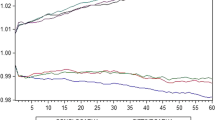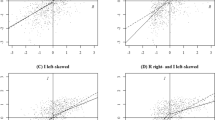Abstract
In this study we develop a new measure of firm-group accounting similarity which captures co-movement in accounting fundamentals over time. We calculate the mean of (1) the average pair-wise correlation between earnings and cash flows for a group of firms and (2) the average pair-wise \(R^2\) from regressing firm i’s earnings (cash flows) on firm j’s earnings (cash flows) within-group. We analyze how the four most widely used industrial classification schemes perform in relation to our measure. We document that the within-industry information transfer contagion effect is increasing in our measure. We confirm that within-industry similarity for the average industry varies widely and is the reason why announcement contagion effects are not observed in certain industries. Lastly, we show that the number of analysts following an industry increases in our measure of industry closeness. From an investor’s standpoint, the new measure enables them to better discern whether the performance of a group of firms is related over time. From a researcher’s standpoint, the new measure enables them to more accurately control for industry effects by capturing the fact that within-industry similarity varies across industries.



Similar content being viewed by others
Notes
e.g. Standard Industrial Classification (SIC), Global Industrial Classification (GIC), North American Industrial Classification (NAICS) and Fama-French (FF).
The correlation matrix determinant captures co-movement in a different way than individual off-diagonal correlations.
See Table 2.
The highest decile of closeness.
De Franco et al. (2011) provide evidence that their measure is positively related to analyst forecast accuracy and negatively related to analyst forecast dispersion.
Our results are robust to using only earnings or cash flows in the calculation of \(C_1\).
Based on the properties of the Pearson Correlation and determinants of two-by-two correlation matrices.
Both types of co-movement indicate close groups since either type aids in predicting the fundamentals of the whole group by observing the fundamentals of one or more firms in that group.
For example, certain accounting regulations may affect certain firms differently in how they account for specific economic transactions. This difference in accounting treatment would effect the earnings portion of our ex post closeness measure (not the cash flow portion). Our measure cannot delineate between the effect on ex post co-movement of the difference in accounting for given economic events and the ex ante exposure to different economic events.
GIC 6-digit industries are at the same level of granularity as SIC 2-digit industries.
See Sect. 5 for the criteria we used in determining the “leader” of a given industry in a given year and a more detailed discussion on the trading strategy results.
Results are robust to using 8 or 16 previous quarterly numbers as well as using 5 previous annual numbers. Also, although the GIC, NAICS and FF schemes came along before the start of our sample time period, COMPUSTAT back fills the firm industry codes for these schemes.
Co-movement in earnings and cash flows needs to be measured over the same calendar time period. Otherwise there will be some macro-level economic events which some firms experience that other firms don’t experience. This will add noise to the closeness measures. 12/31 fiscal year-end firms comprise 67% of the firm-years in COMPUSTAT.
We leave out the tables for each scheme displaying industry-year closeness for our entire sample time period due to space constraints. These tables are available upon request.
Mean of the 25 \(\mathcal {C}\) values over 1990–2014 for each industry.
Technically our sample period is from 1988–2014 but we only look at contagion effects resulting from earnings announcements between 1990–2014. We need the extra years because the closeness is calculated using earnings and cash flow data over the previous 12 quarters for each year between 1990–2014. Also, quarterly cash flow data (OANCFY) is not reported in the merged database until 1987.
We use earnings before extraordinary items (IBQ) and net cash flows from operating activities (OANCFY) to measure earnings and cash flows respectively. To calculate operating cash flows in a quarter we take the quarterly change in OANCFY.
Co-movement in earnings and cash flows needs to be measured over the same calendar time period. Otherwise there will be some macro-level economic events which some firms experience that other firms don’t experience. This will add noise to the closeness measures.
Our results are robust although not as significant when we use “largest assets” to delineate the leader.
There are 67, GIC 6-digit industries. See https://www.msci.com/gics.
Using the Fama and French (1993) 3-factor model produces similar results.
We did not use analysts forecasts to evaluate the “news” due to limited data availability over our sample period. I/B/E/S has much more limited data coverage than CRSP (especially over the early years in our sample period) and we wanted to maintain a representative sample.
A simple regression of the peer cumulative abnormal returns on the news of the leaders pooled over all three windows produces a coefficient of 0.0873 (p value = 0.0000 and \(R^2=0.28\%.\))
The results are similar if comparing the contagion effects between the 1st and 5th quintiles of industry closeness.
Petersen (2009)
The Table 6 result is robust to the following specifications: (1) Using quarterly data over the previous 16 months (instead of 12 months) to measure \(\mathcal {C}\) for each industry-year; (2) Using annual accounting data over the previous 5 years to measure \(\mathcal {C}\) instead of quarterly data to measure \(\mathcal {C}\) for each industry-year; (3) Using net income and total cash flows instead of earnings before extraordinary items and operating cash flows as inputs in calculating \(\mathcal {C}\); (4) Measuring industry closeness using one of the other industrial classification schemes such as SIC2, NAICS3 or FF.
Recall Fig. 3.
We determine this in unreported simulation analysis.
See footnote 10 in GL (2008). They add an additional 185 restatement events identified through their extensive review of approximately 2200 pertinent WSJ articles. These 185 events make up less than 20% of their initial sample (before applying their sample criteria cuts) and there is no reason to believe these events are qualitatively different enough from the ones contained in the GAO database to justify their inclusion to maintain a “representative” sample. Furthermore, this process requires considerable amount of time and effort since 2200 WSJ articles must be read carefully. Consequently we do not augment our sample following GL (2008).
Nearly every eight-digit GICS code was represented.
We follow GL (2008) in this respect. Our results are entirely robust to using six-digit GIC codes or two-digit SIC codes.
Again, we care about the closeness of the industry, not just the pair-wise closeness of firm i with each of its peers for the same reason as discussed earlier after H1 and H2.
These control variables are defined in Table 10.
We also estimate Eq. (3) where \(\mathcal {C}\) is the average of all pair-wise closeness values between peer i and each of its peers instead of the usual specification which considers all possible pairs of firms in firm i’s industry. The coefficient on \(\mathcal {C}\) in this specification was also significantly greater than zero but not as significant (\(\beta _2 = 0.332\), t-stat = 4.73).
References
Aharony J, Swary I (1983) Contagion effects of bank failures: evidence from capital markets. J Bus 56:305–322
Akhigbe A, Madura J, Martin AD (2015) Intra-industry effects of negative stock price surprises. Rev Quant Financ Acc 45(3):541–559
Baginski SP (1987) Intraindustry information transfers associated with management forecasts of earnings. J Account Res 25:196–216
Barth ME, Kasznik R, McNichols MF (2001) Analyst coverage and intangible assets. J Account Res 39:1–34
Bhojraj S, Lee C (2002) Who is my peer? a valuation-based approach to the selection of comparable firms. J Account Res 40(2):407–439
Bhojraj S, Lee C, Oler DK (2003) What’s my line? a comparison of industry classification schemes for capital market research. J Account Res 41(5):745–774
Bhushan R (1989) Firm characteristics and analyst following. J Account Econ 11(2):255–274
Bowen RM, Castanias RP, Daley LA (1983) Intra-industry effects of the accident at three mile island. J Financ Quant Anal 18(01):87–111
Brennan MJ, Hughes PJ (1991) Stock prices and the supply of information. J Financ 46(5):1665–1691
Chan LK, Lakonishok J, Swaminathan B (2007) Industry classifications and return comovement. Financ Anal J 63(6):56–70
Chang S-C, Lai J-H, Yu C-H (2005) The intra-industry effect of share repurchase deregulation: evidence from taiwan. Rev Pac Basin Financ Mark Polic 8(02):251–277
Clinch GJ, Sinclair NA (1987) Intra-industry information releases: a recursive systems approach. J Account Econ 9(1):89–106
De Franco G, Kothari S, Verdi RS (2011) The benefits of financial statement comparability. J Account Res 49(4):895–931
Docking DS, Hirschey M, Jones E (1997) Information and contagion effects of bank loan-loss reserve announcements. J Financ Econ 43(2):219–239
Ettredge ML, Richardson VJ (2003) Information transfer among internet firms: the case of hacker attacks. J Inf Syst 17(2):71–82
Fama EF, French KR (1993) Common risk factors in the returns on stocks and bonds. J Financ Econ 33(1):3–56
Ferris SP, Jayaraman N, Makhija AK (1997) The response of competitors to announcements of bankruptcy: an empirical examination of contagion and competitive effects. J Corp Financ 3(4):367–395
Firth M (1996) Dividend changes, abnormal returns, and intra-lndustry firm valuations. J Financ Quant Anal 31(02):189–211
Foster G (1981) Intra-industry information transfers associated with earnings releases. J Account Econ 3(3):201–232
Freeman R, Tse S (1992) An earnings prediction approach to examining intercompany information transfers. J Account Econ 15(4):509–523
Gleason CA, Jenkins NT, Johnson WB (2008) The contagion effects of accounting restatements. Account Rev 83(1):83–110
Han JC, Wild JJ (1990) Unexpected earnings and intraindustry information transfers: further evidence. J Account Res 28:211–219
Hoberg G, Phillips G (2016) Text-based network industries and endogenous product differentiation. J Polit Econ 124(5):1423–1465
Hrazdil K, Scott T (2013) The role of industry classification in estimating discretionary accruals. Rev Quant Financ Acc 40(1):15–39
Lang MH, Lundholm RJ (1996) Corporate disclosure policy and analyst behavior. Account Rev 467–492
Lang LH, Stulz R (1992) Contagion and competitive intra-industry effects of bankruptcy announcements: an empirical analysis. J Financ Econ 32(1):45–60
Lee CM, Ma P, Wang CC (2015) Search-based peer firms: aggregating investor perceptions through internet co-searches. J Financ Econ 116(2):410–431
O’Brien PC, Bhushan R (1990) Analyst following and institutional ownership. J Account Res 55–76
Olsen C, Dietrich JR (1985) Vertical information transfers: the association between retailers’ sales announcements and suppliers’ security returns. J Account Res 23:144–166
Petersen MA (2009) Estimating standard errors in finance panel data sets: comparing approaches. Rev Financ Stud 22(1):435–480
Pownall G, Waymire G (1989) Voluntary disclosure choice and earnings information transfer. J Account Res 27:85–105
Pyo Y, Lustgarten S (1990) Differential intra-industry information transfer associated with management earnings forecasts. J Account Econ 13(4):365–379
Ramnath S (2002) Investor and analyst reactions to earnings announcements of related firms: an empirical analysis. J Account Res 40(5):1351–1376
Veldkamp LL (2006) Information markets and the comovement of asset prices. Rev Econ Stud 73(3):823–845
Author information
Authors and Affiliations
Corresponding author
Additional information
We thank Charles Lee for his helpful comments and suggestions which have improved the flow and contribution of our paper. We also gratefully acknowledge the helpful comments and suggestions of John Fellingham, Hong Xie and workshop participants at the University of Kentucky, Rutgers University and Binghamton University.
Rights and permissions
About this article
Cite this article
Ross, J., Ziebart, D. & Meder, A. A new measure of firm-group accounting closeness. Rev Quant Finan Acc 52, 1137–1161 (2019). https://doi.org/10.1007/s11156-018-0739-0
Published:
Issue Date:
DOI: https://doi.org/10.1007/s11156-018-0739-0




